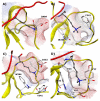Drug discovery toward antagonists of methyl-lysine binding proteins
- PMID: 22145013
- PMCID: PMC3229088
- DOI: 10.2174/1875397301005010051
Drug discovery toward antagonists of methyl-lysine binding proteins
Abstract
The recognition of methyl-lysine and -arginine residues on both histone and other proteins by specific "reader" elements is important for chromatin regulation, gene expression, and control of cell-cycle progression. Recently the crucial role of these reader proteins in cancer development and dedifferentiation has emerged, owing to the increased interest among the scientific community. The methyl-lysine and -arginine readers are a large and very diverse set of effector proteins and targeting them with small molecule probes in drug discovery will inevitably require a detailed understanding of their structural biology and mechanism of binding. In the following review, the critical elements of methyl-lysine and -arginine recognition will be summarized with respect to each protein family and initial results in assay development, probe design, and drug discovery will be highlighted.
Keywords: Histones; chemical probes; chromatin; drug discovery.; methyl-arginine; methyl-lysine; pi-cation interactions; post-translational modifications; reader domains.
Figures









Similar articles
-
Chemical tools targeting readers of lysine methylation.Curr Opin Chem Biol. 2023 Jun;74:102286. doi: 10.1016/j.cbpa.2023.102286. Epub 2023 Mar 20. Curr Opin Chem Biol. 2023. PMID: 36948085 Free PMC article. Review.
-
Targeting non-bromodomain chromatin readers.Nat Struct Mol Biol. 2019 Oct;26(10):863-869. doi: 10.1038/s41594-019-0290-2. Epub 2019 Oct 3. Nat Struct Mol Biol. 2019. PMID: 31582844 Review.
-
A General TR-FRET Assay Platform for High-Throughput Screening and Characterizing Inhibitors of Methyl-Lysine Reader Proteins.SLAS Discov. 2019 Jul;24(6):693-700. doi: 10.1177/2472555219844569. Epub 2019 Apr 24. SLAS Discov. 2019. PMID: 31017815 Free PMC article.
-
Methyllysine binding domains: Structural insight and small molecule probe development.Eur J Med Chem. 2017 Aug 18;136:14-35. doi: 10.1016/j.ejmech.2017.04.047. Epub 2017 Apr 22. Eur J Med Chem. 2017. PMID: 28478342 Review.
-
Improved methods for targeting epigenetic reader domains of acetylated and methylated lysine.Curr Opin Chem Biol. 2021 Aug;63:132-144. doi: 10.1016/j.cbpa.2021.03.002. Epub 2021 Apr 11. Curr Opin Chem Biol. 2021. PMID: 33852996 Free PMC article. Review.
Cited by
-
Targeting epigenetics for cancer therapy.Arch Pharm Res. 2019 Feb;42(2):159-170. doi: 10.1007/s12272-019-01126-z. Epub 2019 Feb 26. Arch Pharm Res. 2019. PMID: 30806885 Free PMC article. Review.
-
Small-molecule ligands of methyl-lysine binding proteins: optimization of selectivity for L3MBTL3.J Med Chem. 2013 Sep 26;56(18):7358-71. doi: 10.1021/jm400919p. Epub 2013 Sep 16. J Med Chem. 2013. PMID: 24040942 Free PMC article.
-
The L3MBTL3 Methyl-Lysine Reader Domain Functions As a Dimer.ACS Chem Biol. 2016 Mar 18;11(3):722-8. doi: 10.1021/acschembio.5b00632. Epub 2015 Sep 2. ACS Chem Biol. 2016. Retraction in: ACS Chem Biol. 2018 Jan 19;13(1):281. doi: 10.1021/acschembio.7b01061. PMID: 26317848 Free PMC article. Retracted.
-
Sulfopeptide probes of the CXCR4/CXCL12 interface reveal oligomer-specific contacts and chemokine allostery.ACS Chem Biol. 2013 Sep 20;8(9):1955-63. doi: 10.1021/cb400274z. Epub 2013 Jun 26. ACS Chem Biol. 2013. PMID: 23802178 Free PMC article.
-
Developing Spindlin1 small-molecule inhibitors by using protein microarrays.Nat Chem Biol. 2017 Jul;13(7):750-756. doi: 10.1038/nchembio.2377. Epub 2017 May 15. Nat Chem Biol. 2017. PMID: 28504676 Free PMC article.
References
-
- Bhaumik SR, Smith E, Shilatifard A. Covalent modifications of histones during development and disease pathogenesis. Nat Struct Mol Biol. 2007;14:1008–16. - PubMed
-
- Wang GG, Allis CD, Chi P. Chromatin remodeling and cancer, Part I: Covalent histone modifications. Trends Mol Med. 2007;13:363–72. - PubMed
-
- Jenuwein T, Allis CD. Translating the histone code. Science. 2001;293:1074–80. - PubMed
-
- Strahl BD, Allis CD. The language of covalent histone modifications. Nature. 2000;403:41–5. - PubMed
-
- Zhang Y, Reinberg D. Transcription regulation by histone methylation: interplay between different covalent modifications of the core histone tails. Genes Dev. 2001;15:2343–60. - PubMed
Grants and funding
LinkOut - more resources
Full Text Sources
Other Literature Sources
Research Materials
Miscellaneous
